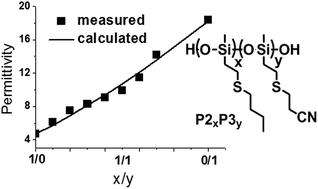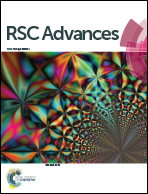Fine-tuning of the dielectric properties of polysiloxanes by chemical modification†
Abstract
A series of novel polysiloxanes is presented, the glass transition temperatures and dielectric properties of which are systematically fine-tuned by utilizing thiol-ene post-polymerization reactions. The pendant vinyl groups of a high molecular weight polymethylvinylsiloxane P1 were exhaustively reacted with the thiol compounds 1-butanethiol (2) and 3-mercaptopropionitrile 3 both separately to give polymers P2 and P3, respectively, as well as in various ratios x, y so as to create materials P2xP3y with greatly differing contents of the polar nitrile group (y). All modifications proceeded quantitatively as was confirmed by 1H NMR spectroscopy. Because of the presence of the polarizable thioether and nitrile groups, the resulting siloxane polymers exhibit permittivity ranging from ε′ = 4.7 to 18.4 for P2 and P3, respectively. The ε′ values of all polymers P2xP3y carrying more than one kind of thiolether group lie within this range. Additionally, broadband dielectric spectroscopy measurements of P2, P21P31 and P3 have been conducted in the temperature range from −150 °C to 60 °C and the frequency range from 0.1 Hz to 1 MHz. Due to their high permittivity, polymers P2, P2xP3y and P3 are attractive candidates for dielectric elastomer actuators and flexible electronics.


 Please wait while we load your content...
Please wait while we load your content...